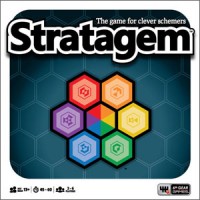
Stratagem
The following is a paid preview for an (upcoming) Kickstarter project. The art work, components and rules are not in their final form.
Overview
In Stratagem players vie for control of hexes that will yield points if they are able to maintain control of those spaces. Move across the game board claiming spaces as you go. If you manage to hold on to those spaces until your next turn, you claim them for points. Players can also land on opponent’s pawns and battle for control of a hex. The first player to score a predetermined number of points is the winner.
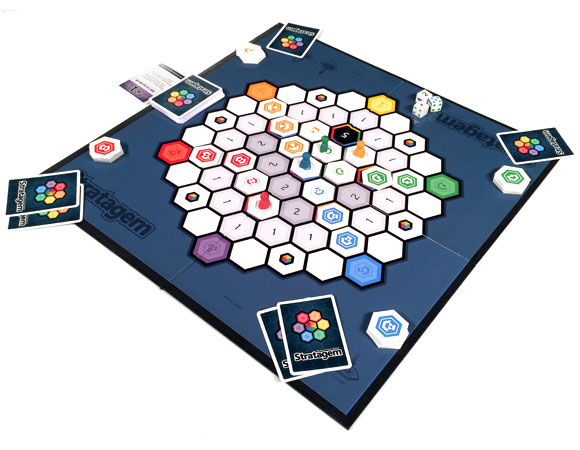
Set Up
The game board is laid out and players choose starting spaces opposite from one another depending upon the number of players. Players then take the player pawn and hex tiles matching their color and place their pawns on their player color’s starting hex. Then the deck of Action cards is shuffled and three cards are dealt to each player face down. This is their starting hand. One of the multi-colored six-sided dice is rolled, and the color rolled becomes the first player. The game is ready to begin.

Goal
The object of Stratagem is to be the first to score a predetermined number of points. The point goal depends on the number of players. The rules suggest: 100 Points for a 2-3 player game, 75 points for 4-5 players and 50 points for the 6-player all out Stratagem war! You can fiddle with the point totals if you wish – but the suggested point goals above will result in an average game length of 45-60 minutes. The points are located in a specific pattern on the game board. No points are in the perimeter spaces, followed by 1’s, 2’s, 5’s and the big 10 space in the middle of the board.
Some Hex Tile Info…
As we describe the player turn and how points are scored it’s important to know the hex tiles (each player starts with 10) used in the game have two sides:
- Claim position: a lighted colored design
- Control position: the darker more “filled-in” design

Gameplay
A player’s turn couldn’t be simpler: Clear, Control and Claim. (In each player’s first turn, they only perform the Claim phase.)

Clear
The first phase requires a player to clear from the board all their tokens that are in the Control position; that is with the darker design face up.
Control
Now, all of a player’s hex tokens that are on the board in the Claim position get flipped over to the Control position and that player scores a number of points equal to the number on that hex. Another important point: spaces that contain a hex token in the Control position may only be entered by the player who controls that hex token.
Claim
The acting player now rolls the movement die and must move their pawn the exact number of spaces indicated by the die. A player then places a hex token on each space they entered with its “Claim” side face up. A player may move onto (and thus claim for their own) any hex space that has been claimed by another player. (Remember a space that is controlled by another player is off limits!) A player may also move onto spaces they already control, but can’t “backtrack” across a space they just claimed in the same turn.
Battle!
If a player’s pawn enters a space occupied by another player’s pawn, movement stops and a Battle ensues. Each player rolls one Battle die. The player with the higher result wins. (Ties go the defender). The winner of the battle may now remove the opposing player’s Claim hex tile and claim that space with their own hex tile! The defeated player must remove their pawn and place it back on their starting hex. Agh!
Action Cards are cool
Each Player begins with three of these little beauties. Only one Action card may be played in a player’s turn. That is, one Action card can be played in a players own turn, and one can be played in any opposing player’s turn.
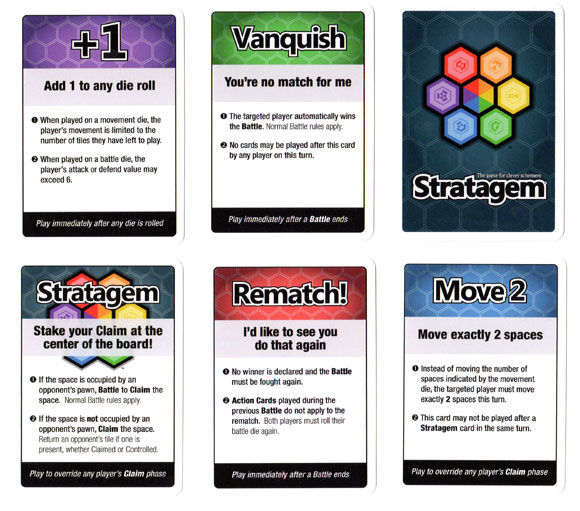
Each Action card itself explains when that card can be played. Actions cards have various effects like: adding to and subtracting from die rolls, moving around the board, nullifying Battle results and so forth. The big card “Stratagem” allows a player to claim the center hex of the board if it is un-occupied. If occupied a player may Battle for it.
Players can draw more Action cards by controlling spaces that have the special rainbow hex symbol in the middle.
Gameplay Rule Variants
There were several variants included in this preview version of the game. These may or may not make it into the final version – but we played them all!
Two-player Variant
Two players can play the game with one color each or in this variant, control two colors each (setting up as in a four player game). Turns are taken separately, and alternating, but each player keeps one combined score.
Adjacent Spaces in Battle
In Battle, players roll the dice as usual but may add 1 to the die roll for each claimed and controlled adjacent space in their player color. Adjacent Claimed spaces add 1 point each, and adjacent Controlled spaces add 2 points each. The Defender has the added benefit of adding the hex the battle is taking place in to their total.
No Battle Dice
Using the “Adjacent Spaces in Battle” variant above, Battles are decided purely on the total points by calculating adjacent claimed and controlled hexes.
No Movement Die
During the Claim phase, each player must move exactly three spaces. No movement die is rolled.
Pure Strategy
All random elements are removed from the game. No Battle die or movement die is rolled and the Action card deck is removed from gameplay.
Learning Curve
Way low. Very easy to learn and play. Players can begin a game with a very simple strategy and straightforward action phases. However, once the player interaction starts the complexity increases.
Who would enjoy this game?
Family Gamer {yes}
Stratagem is an accessible abstract strategy game that is neither too simple, nor too complex. Player choices are varied enough to be interesting but not so abundant as to cause a brain ache. Although listed ages 13+, it can be played with those as young as eight since very little reading is needed. However, some of the variants raise the age requirement as complexity increases.
Social Gamer {no}
Played with 6 players the game is crazy. Interaction is very high and points are difficult to come by. We wouldn’t say it caters towards the social experience you would get from a party game.
Strategy Gamer {yes}
Stratagem at its heart is an abstract strategy game. It presents some very unique strategic decisions. With the variants, the level of random gameplay elements can be tuned to appeal to the strategy “purest.” However, long term strategy is difficult with more players due to the immediate and frequent player interaction. Definitely worth a look for Strategy gamers playing with fewer players.
Casual Gamer {maybe}
The low learning curve and ease of set up make the game playable immediately. It’s very accessible. The more random elements such as the die rolls and the Action cards make the game appealing to the “not-too-serious’ gamer. Casual players may want to avoid the lower player numbers. With 2-3 players the game is much more strategic. With 4-6 players however, there’s lots of action with less “thinky” and more “argh!” moments.
Avid Gamer {maybe}
For gamers who want to try a little of everything, this game presents some great player interaction and competitive gameplay. The only caveat is that there is little theme, so Avid gamers who don’t need vibrant illustrations will be pleased. It just depends on the types of games you enjoy.
Power Gamer {no}
Stratagem doesn’t produce the kind of intensity a Power gamer craves. Although the game can produce some great competition and serious moments, it’s not complex and doesn’t offer game length strategic arcs. Not really in the Power gamer’s wheelhouse.
First Impressions
First and foremost, it must be said that the components for this preview copy are not final, but they were excellent, A very tight design with good synergy and simple and appealing graphics. Can’t wait to see the final version!
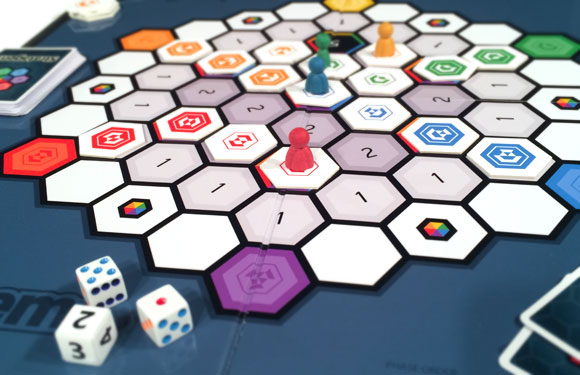
As is required of most abstract strategy games, the game mechanics are pure: Clear, Claim and Control (after two turns you’ve got it.) One defining factor in Stratagem is the game board and the specific spaces on it. Point values on the spaces create higher valued hexes than others. This then creates a specific motivation in each move made. Clearly players are enticed, no, more like compelled to get to the center of the board where the higher point hexes are. Stay on the outskirts to “avoid” interaction and you’ll be in last place.
The next defining mechanic is the two-stage capture requirement in a player’s move. In most abstract strategy games, (and many other games) a move to capture or score is made in one action. In Stratagem players must claim spaces before they control and score them, and this process takes one full turn. In other words, you can hope to score the points under the spaces you claim, however your opponents may have something to say about that. Having opponents march across your claimed hexes is par for the course – then again turnabout is always fair play.
The PvP battle that ensues when two players find themselves contesting ownership of the same space seems a bit random in a sea of pure strategy. However, the ability to send the defeated player’s pawn back to their start space can be a great move especially when they are closing in on a victory – or just in your hair.
The Action cards give the game that little extra “take that!” quality that other abstract strategy games lack. None of them are too powerful, but at key moments in tight games they can really ruin your day (or make it)!
A word about the variants. Most abstract strategy games don’t include random elements and rely on the sheer mathematics – the absolute computation of the basic game mechanics – to achieve victory. In these games, if a person’s brain was big enough, they could plan every single move and counter move and compute all the possible future outcomes. The variants in Stratagem offer a chance for the game to exist in this absolute state. After playing all the variants, it’s clear that the game is very pliable and to its credit the foundation of rules is strong enough to add randomizers to offer a different play experience – but one that doesn’t stray too far from the original intent. The random elements also increase the replay value simply based on the chaotic nature of the dice rolls. Take the dice rolls away, and the replay value is proportionate to players’ ability to enact their own strategies based on opponents’ moves and countermoves.
Almost Final Thoughts
With the game still in development, there may be changes forthcoming. If the randomness of a die roll combined with strategic and tactical movement appeals to you, this game has it. Strip away the die rolls with some of the variant rules, and there is also a game here for the abstract strategy purest.

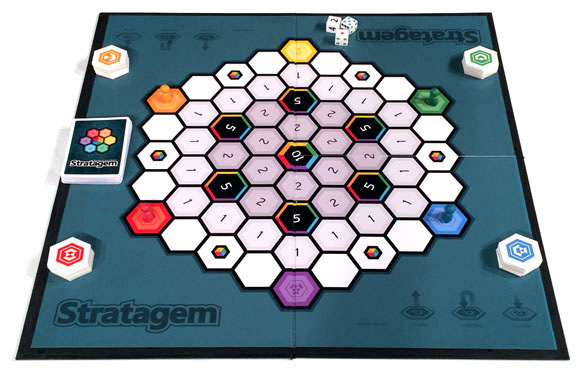

Game should be released in TBD, so watch the news!